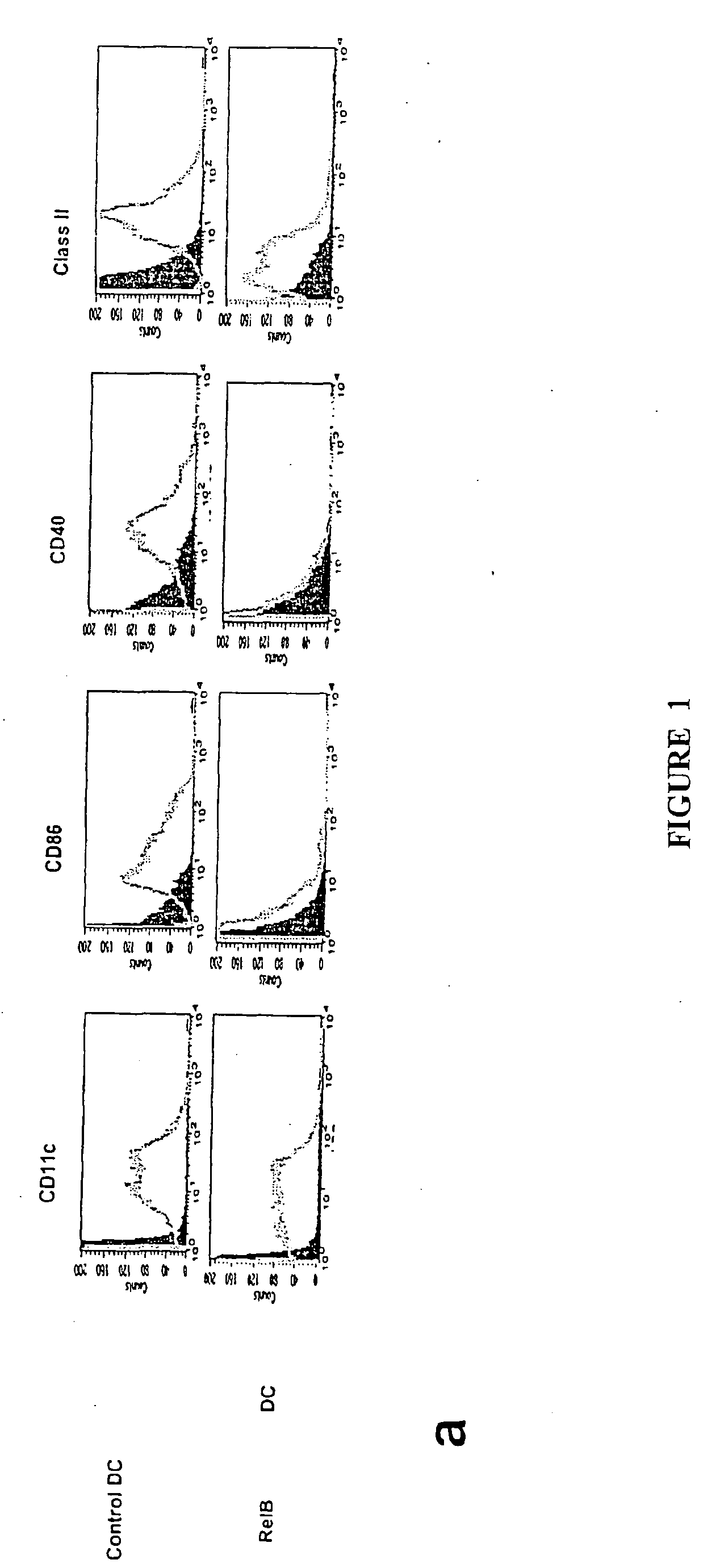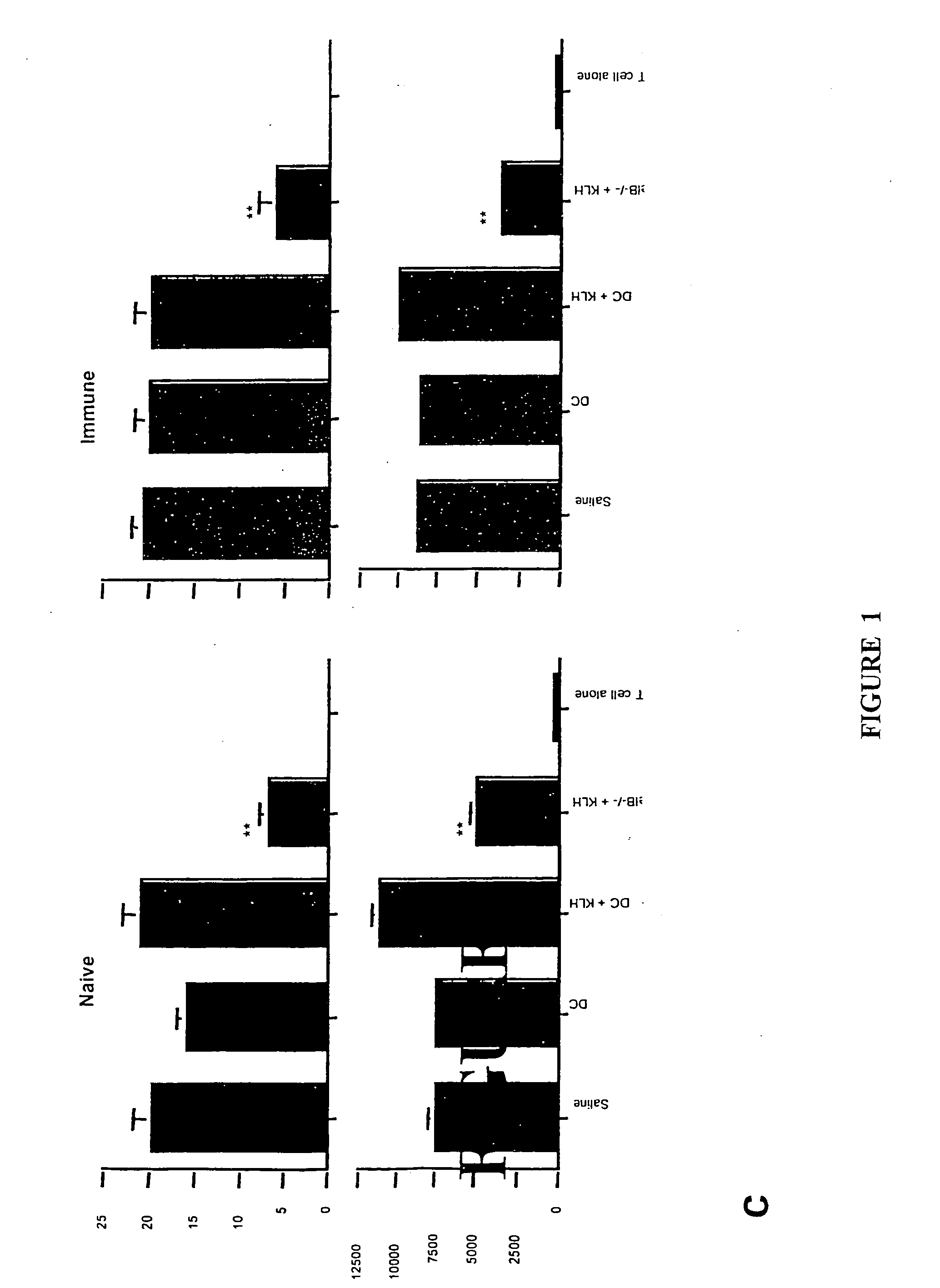Immunomodulating compositions, processes for their production and uses therefor
a technology of immunomodulation and composition, applied in the field of immunomodulation composition, can solve the problems of non-specific antigen-specific approach, reversible, and inability to demonstrate the suppression of previously primed cd4sup>+/sup> t cell responses by dcs in vivo
- Summary
- Abstract
- Description
- Claims
- Application Information
AI Technical Summary
Benefits of technology
Problems solved by technology
Method used
Image
Examples
example 1
Inhibition of Myeloid Dc Differentiation and Antigen-Specific Suppression of Primed Immune Responses by Inhibition of Relb Function
[0140] Translocation of the NFκB family members RelB and p50 from cytoplasm to nucleus is required for myeloid DC maturation (Burkly et al., 1995). To assess the relationship between RelB, differentiation, and tolerance induction by myeloid DCs, BMDCs were generated from homozygous H-2b RelB− / − or wild type H-2b mice. RelB− / − BMDCs did not express CD40, and expressed lower levels of MHC class 11 and CD86 than RelB+ / + BMDCs (FIG. 1a). The ability of s.c. adoptively-transferred mBSA-pulsed RelB− / − BMDCs to prime an antigen-specific T cell proliferative response in naïve wild type H-2b mice was reduced, compared with mBSA-pulsed RelB+ / + BMDCs (FIG. 1b). To test tolerance induction, wild type H-2b mice were injected s.c. with 5×105 KLH-pulsed DCs 7 days before or 7 days after priming with KLH in CFA. KLH-specific immunity was tested 5d after DC or KLH admi...
example 2
Suppression of Primed Immune Responses by DCS Correlates with their RelB Nuclear Binding Activity and CD40 Expression
[0145] Previously, immature BM or monocyte-derived DCs have been shown to regulate immune responses (Dhodapkar et al., 2001; Jonuleit et al., 2000). Since DCs in which RelB nuclear translocation is inhibited suppressed a primed immune response, the capacity of DCs prepared ex vivo to suppress immunity was correlated with RelB activity in nuclear extracts. BMDCs were generated in serum-containing medium either in GM-CSF and IL-4 (control DCs), in GM-CSF alone (“immature DCs”), (Lutz et al., 2000) or in BAY, GM-CSF and L-4, then pulsed with KLH and injected s.c. into mice primed 7 days previously with KLH and CFA. Immature DCs expressed lower levels of CD86, CD40, and class II than control DCs. By contrast, BAY-treated DCs expressed higher levels of CD86 and reduced CD40 compared with immature DCs (FIG. 4a). Suppression by DCs of KLH-specific draining LN T cell respon...
example 3
CD40 Deficiency is Sufficient to Confer Suppression of Immunity by DCs.
[0146] Since RelB deficient and BAY-treated BMDCs lacked cell surface CD40, and suppression of immunity by DCs correlated with CD40 expression, we determined whether lack of CD40 expression by antigen-exposed BMDCs was sufficient for suppression of previously primed immunity. DCs generated from CD40− / − BM in the presence or absence of BAY were similar in phenotype to RelB-deficient DCs, except for higher cell surface CD86 expression (FIG. 5a). DCs generated from BM of H-2d CD40− / − or CD40+ / + mice in the presence or absence of BAY were pulsed with KLH and administered s.c. to wild type H-2d mice 7 days after priming with KLH in CFA. Administration of DCs generated from CD40− / − BM conferred equivalent suppression of a previously primed immune response to DCs generated from either CD40− / − or CD40+ / + BM in the presence of BAY (FIGS. 5b, c).
PUM
| Property | Measurement | Unit |
|---|---|---|
| time | aaaaa | aaaaa |
| volume | aaaaa | aaaaa |
| volume | aaaaa | aaaaa |
Abstract
Description
Claims
Application Information
 Login to View More
Login to View More - R&D
- Intellectual Property
- Life Sciences
- Materials
- Tech Scout
- Unparalleled Data Quality
- Higher Quality Content
- 60% Fewer Hallucinations
Browse by: Latest US Patents, China's latest patents, Technical Efficacy Thesaurus, Application Domain, Technology Topic, Popular Technical Reports.
© 2025 PatSnap. All rights reserved.Legal|Privacy policy|Modern Slavery Act Transparency Statement|Sitemap|About US| Contact US: help@patsnap.com



